英语文体学简介
- 格式:doc
- 大小:48.50 KB
- 文档页数:6


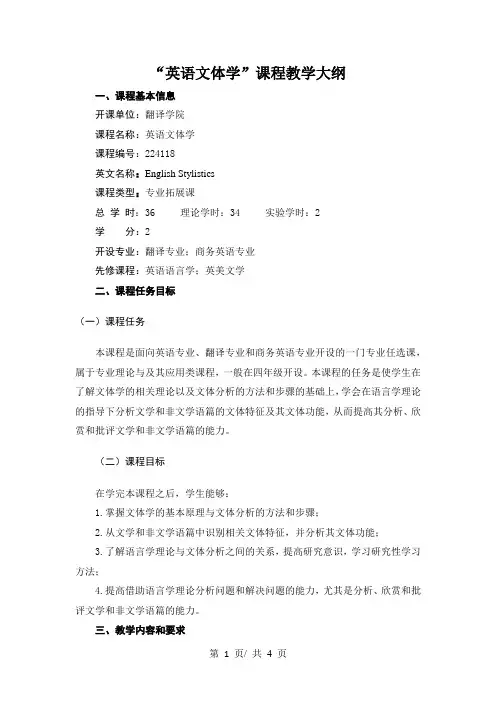
“英语文体学”课程教学大纲一、课程基本信息开课单位:翻译学院课程名称:英语文体学课程编号:224118英文名称:English Stylistics课程类型:专业拓展课总学时:36 理论学时:34 实验学时:2学分:2开设专业:翻译专业;商务英语专业先修课程:英语语言学;英美文学二、课程任务目标(一)课程任务本课程是面向英语专业、翻译专业和商务英语专业开设的一门专业任选课,属于专业理论与及其应用类课程,一般在四年级开设。
本课程的任务是使学生在了解文体学的相关理论以及文体分析的方法和步骤的基础上,学会在语言学理论的指导下分析文学和非文学语篇的文体特征及其文体功能,从而提高其分析、欣赏和批评文学和非文学语篇的能力。
(二)课程目标在学完本课程之后,学生能够:1.掌握文体学的基本原理与文体分析的方法和步骤;2.从文学和非文学语篇中识别相关文体特征,并分析其文体功能;3.了解语言学理论与文体分析之间的关系,提高研究意识,学习研究性学习方法;4.提高借助语言学理论分析问题和解决问题的能力,尤其是分析、欣赏和批评文学和非文学语篇的能力。
三、教学内容和要求Chapter 1 Introduction本章是整个课程的导入部分,目的是让学生了解文体学的定义及其产生背景和过程、理论假设以及文体学研究的目标和文体分析的基本步骤,并了解文体学的基本特征。
具体内容如下:Defining stylistics;Naissance of stylistics as an interdisciplinary field of study;Two important assumptions of stylistics;Goals, components and procedure of stylistic inquiry;Nature of stylistic analysis。
Chapter 2 On style本章在介绍文体学界的三种典型文体观的基础上,列举文体的分类特征,讨论多种英语变体的基本特征,并分析文体的正式程度及其语言表现形式。
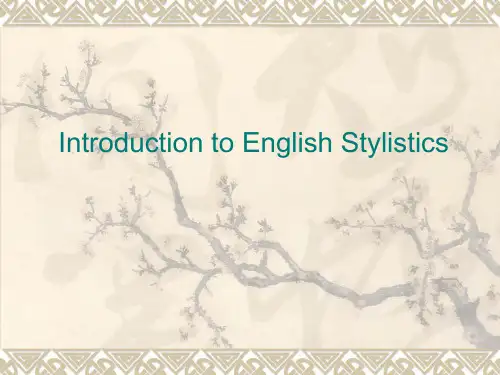
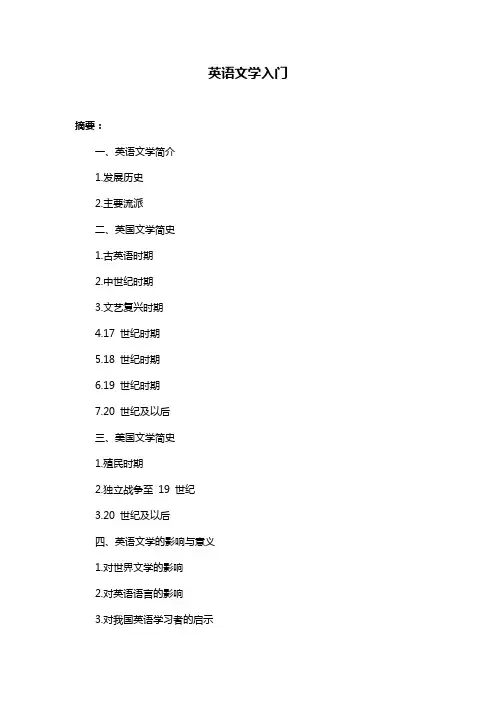
英语文学入门摘要:一、英语文学简介1.发展历史2.主要流派二、英国文学简史1.古英语时期2.中世纪时期3.文艺复兴时期4.17 世纪时期5.18 世纪时期6.19 世纪时期7.20 世纪及以后三、美国文学简史1.殖民时期2.独立战争至19 世纪3.20 世纪及以后四、英语文学的影响与意义1.对世界文学的影响2.对英语语言的影响3.对我国英语学习者的启示正文:英语文学入门英语文学是世界上最丰富、最具影响力的文学之一。
它拥有悠久的历史,经历了多个阶段的发展,产生了许多杰出的作家和作品。
了解英语文学的发展历程和主要成就,不仅有助于提高英语水平,还能丰富我们的文化素养。
一、英语文学简介英语文学起源于古英语时期,大约公元5 世纪。
经过中世纪、文艺复兴、17 世纪、18 世纪、19 世纪等阶段的发展,形成了现代英语文学的格局。
20 世纪以后,英语文学不断创新,涌现出一批又一批优秀的作家和作品。
二、英国文学简史1.古英语时期(Old English):这一时期的文学以史诗和诗歌为主,代表作品有《贝奥武甫》(Beowulf)和《埃达》(Elder Edda)。
2.中世纪时期(Medieval):这一时期以教会文学和骑士文学为主,著名作品有《亚瑟王传奇》(Le Morte d"Arthur)和《罗宾逊·克鲁索》(Robinson Crusoe)。
3.文艺复兴时期(Renaissance):这一时期以人文主义文学为主,代表作家有莎士比亚、培根、斯宾塞等。
4.17 世纪时期(17th century):这一时期以清教徒文学和骑士文学为主,代表作品有约翰·弥尔顿的《失乐园》(Paradise Lost)。
5.18 世纪时期(18th century):这一时期以启蒙运动文学为主,代表作家有丹尼尔·笛福、乔纳森·斯威夫特、塞缪尔·约翰逊等。
6.19 世纪时期(19th century):这一时期是英国文学的黄金时代,包括浪漫主义、现实主义和维多利亚时期。
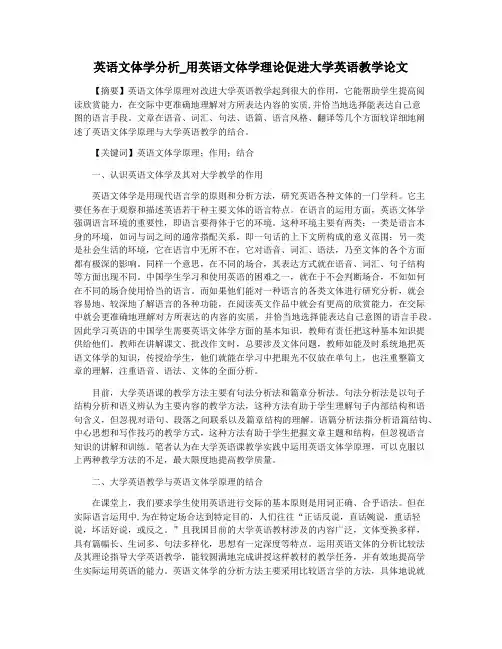
英语文体学分析_用英语文体学理论促进大学英语教学论文【摘要】英语文体学原理对改进大学英语教学起到很大的作用,它能帮助学生提高阅读欣赏能力,在交际中更准确地理解对方所表达内容的实质,并恰当地选择能表达自己意图的语言手段。
文章在语音、词汇、句法、语篇、语言风格、翻译等几个方面较详细地阐述了英语文体学原理与大学英语教学的结合。
【关键词】英语文体学原理;作用;结合一、认识英语文体学及其对大学教学的作用英语文体学是用现代语言学的原则和分析方法,研究英语各种文体的一门学科。
它主要任务在于观察和描述英语若干种主要文体的语言特点。
在语言的运用方面,英语文体学强调语言环境的重要性,即语言要得体于它的环境。
这种环境主要有两类:一类是语言本身的环境,如词与词之间的通常搭配关系,即一句话的上下文所构成的意义范围;另一类是社会生活的环境,它在语言中无所不在,它对语音、词汇、语法,乃至文体的各个方面都有极深的影响。
同样一个意思,在不同的场合,其表达方式就在语音、词汇、句子结构等方面出现不同。
中国学生学习和使用英语的困难之一,就在于不会判断场合,不知如何在不同的场合使用恰当的语言。
而如果他们能对一种语言的各类文体进行研究分析,就会容易地、较深地了解语言的各种功能,在阅读英文作品中就会有更高的欣赏能力,在交际中就会更准确地理解对方所表达的内容的实质,并恰当地选择能表达自己意图的语言手段。
因此学习英语的中国学生需要英语文体学方面的基本知识,教师有责任把这种基本知识提供给他们。
教师在讲解课文、批改作文时,总要涉及文体问题,教师如能及时系统地把英语文体学的知识,传授给学生,他们就能在学习中把眼光不仅放在单句上,也注重整篇文章的理解,注重语音、语法、文体的全面分析。
目前,大学英语课的教学方法主要有句法分析法和篇章分析法。
句法分析法是以句子结构分析和语义辨认为主要内容的教学方法,这种方法有助于学生理解句子内部结构和语句含义,但忽视对语句、段落之间联系以及篇章结构的理解。
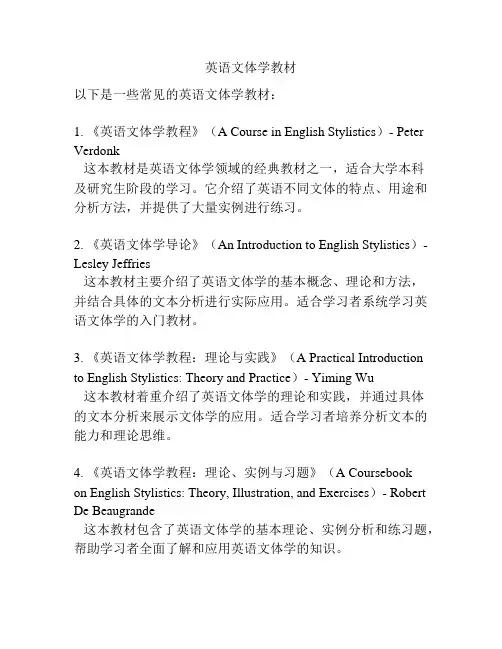
英语文体学教材
以下是一些常见的英语文体学教材:
1. 《英语文体学教程》(A Course in English Stylistics)- Peter Verdonk
这本教材是英语文体学领域的经典教材之一,适合大学本科
及研究生阶段的学习。
它介绍了英语不同文体的特点、用途和分析方法,并提供了大量实例进行练习。
2. 《英语文体学导论》(An Introduction to English Stylistics)- Lesley Jeffries
这本教材主要介绍了英语文体学的基本概念、理论和方法,
并结合具体的文本分析进行实际应用。
适合学习者系统学习英语文体学的入门教材。
3. 《英语文体学教程:理论与实践》(A Practical Introduction to English Stylistics: Theory and Practice)- Yiming Wu
这本教材着重介绍了英语文体学的理论和实践,并通过具体
的文本分析来展示文体学的应用。
适合学习者培养分析文本的能力和理论思维。
4. 《英语文体学教程:理论、实例与习题》(A Coursebook
on English Stylistics: Theory, Illustration, and Exercises)- Robert De Beaugrande
这本教材包含了英语文体学的基本理论、实例分析和练习题,帮助学习者全面了解和应用英语文体学的知识。
以上教材都可以通过一些在线书店或图书馆进行购买或借阅。
此外,还有许多其他的英语文体学教材可供选择,你可以根据自己的具体需求和学习水平选择适合的教材。
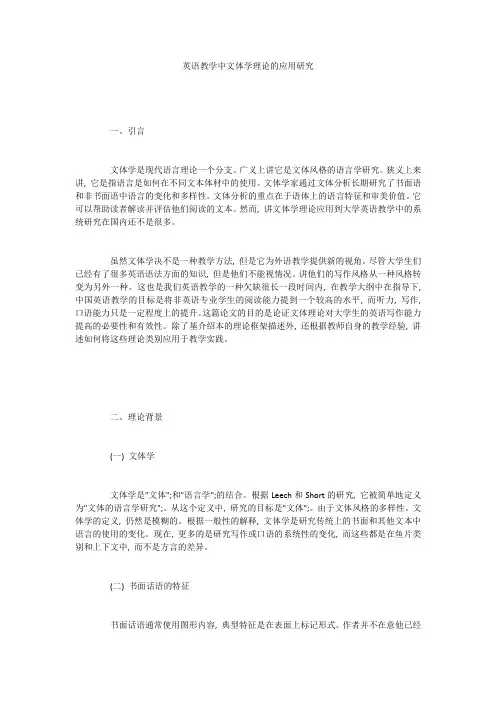
英语教学中文体学理论的应用研究一、引言文体学是现代语言理论一个分支。
广义上讲它是文体风格的语言学研究。
狭义上来讲, 它是指语言是如何在不同文本体材中的使用。
文体学家通过文体分析长期研究了书面语和非书面语中语言的变化和多样性。
文体分析的重点在于语体上的语言特征和审美价值。
它可以帮助读者解读并评估他们阅读的文本。
然而, 讲文体学理论应用到大学英语教学中的系统研究在国内还不是很多。
虽然文体学决不是一种教学方法, 但是它为外语教学提供新的视角。
尽管大学生们已经有了很多英语语法方面的知识, 但是他们不能视情况。
讲他们的写作风格从一种风格转变为另外一种。
这也是我们英语教学的一种欠缺很长一段时间内, 在教学大纲中在指导下, 中国英语教学的目标是将非英语专业学生的阅读能力提到一个较高的水平, 而听力, 写作, 口语能力只是一定程度上的提升。
这篇论文的目的是论证文体理论对大学生的英语写作能力提高的必要性和有效性。
除了基介绍本的理论框架描述外, 还根据教师自身的教学经验, 讲述如何将这些理论类别应用于教学实践。
二、理论背景(一) 文体学文体学是"文体";和"语言学";的结合。
根据Leech和Short的研究, 它被简单地定义为"文体的语言学研究";。
从这个定义中, 研究的目标是"文体";。
由于文体风格的多样性。
文体学的定义, 仍然是模糊的。
根据一般性的解释, 文体学是研究传统上的书面和其他文本中语言的使用的变化。
现在, 更多的是研究写作或口语的系统性的变化, 而这些都是在鱼片类别和上下文中, 而不是方言的差异。
(二) 书面话语的特征书面话语通常使用图形内容, 典型特征是在表面上标记形式。
作者并不在意他已经写过的内容上, 也不会写作时害怕对方打断他的话。
每一个词写完之后都可以停顿一下, 花时间选择一个特定的词, 甚至必要时查字典。
文本是永久的, 可以重读。


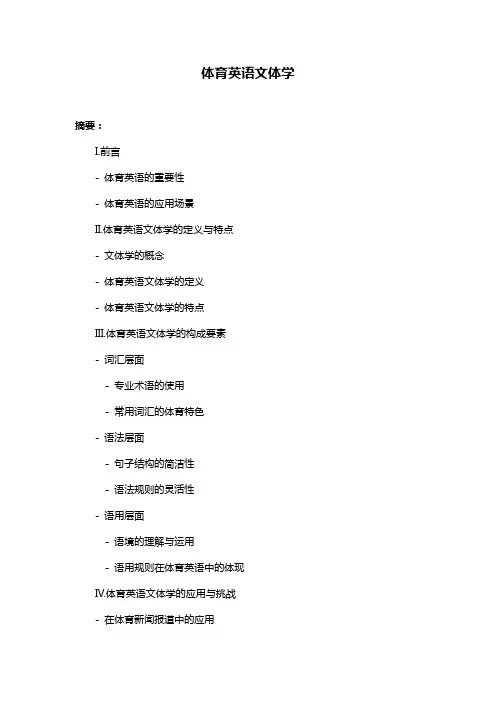
体育英语文体学摘要:I.前言- 体育英语的重要性- 体育英语的应用场景II.体育英语文体学的定义与特点- 文体学的概念- 体育英语文体学的定义- 体育英语文体学的特点III.体育英语文体学的构成要素- 词汇层面- 专业术语的使用- 常用词汇的体育特色- 语法层面- 句子结构的简洁性- 语法规则的灵活性- 语用层面- 语境的理解与运用- 语用规则在体育英语中的体现IV.体育英语文体学的应用与挑战- 在体育新闻报道中的应用- 在体育教育中的应用- 面临的国际化挑战V.结论- 对体育英语文体学的总结- 对未来体育英语发展的展望正文:随着全球体育事业的蓬勃发展,体育英语的重要性日益凸显。
无论是国际体育赛事的新闻报道,还是体育教育中的专业教学,都离不开体育英语。
在这一背景下,体育英语文体学应运而生,它研究的是体育英语在词汇、语法和语用等方面的特殊性。
体育英语文体学,作为一个新兴的领域,有其独特的定义和特点。
首先,文体学是研究语言风格和语言结构的学科,而体育英语文体学则将这一概念运用到体育领域,研究体育英语的特殊风格和结构。
其次,体育英语文体学具有鲜明的体育特色,无论是词汇、语法还是语用,都体现出体育领域的专业性。
在体育英语文体学中,词汇层面是基础,也是关键。
专业术语的使用和常用词汇的体育特色,使得体育英语词汇丰富多样,同时也为体育英语学习者带来了挑战。
语法层面,体育英语文体学的句子结构通常简洁明了,语法规则具有一定的灵活性,这也是体育英语文体学的独特之处。
在语用层面,体育英语文体学强调语境的理解与运用,以及语用规则在体育英语中的体现。
体育英语文体学的应用范围广泛,尤其在体育新闻报道和体育教育中。
专业的体育英语报道,不仅要求准确传达赛事信息,还要注重体育英语文体的运用。
而在体育教育中,体育英语文体学的运用,可以帮助学生更好地理解和掌握体育专业知识,提高他们的专业素质。
然而,体育英语文体学的发展也面临着国际化挑战。
Chapter OneStyle and Stylistics1.1 Introductione.g.(1)“Take an egg, and make a perforation in the base and a corresponding one in the apex. And then, apply the lips to the aperture, and by forcibly inhaling the breath, the shell is entirely discharged of its contents.”“It fair beats all how folks do things nowadays. When I was a gal, they made a hole in each end and sucked.”e.g.(2)(1) My beloved parent has joined the heavenly choir.(2) My dear father has passed away.(3) My father has died.(4) My old man has kicked the bucket.分析:(1) My beloved parent has joined the heavenly choir.(This sentence is very pompous and sententious, elevating the event of John Smith‟s death to a divine status, probably said with respect in a poem or a formal ceremony, addressing an audience of high social status or nobility.)(2) My dear father has passed away.(This sentence is still a bit formal, with sincere loving sentiment, expressing a kind of deep emotion fro his father’s death, addressing people of or above middle class status in a relatively formal occasion.)(3) My father has died.(This sentence is a everyday kind of expression with no emotions revealed, said in an informal occasion, addressing his peers or friends. )(4) My old man has kicked the bucket.(This sentence is slangy, said in a very informal occasion showing disrespect for his father.)e.g.(3)(1) Expectoration is forbidden.(2) Please do not spit.(3) No spitting.(The three sentences state the same fact that : spitting is not allowed, but, they are of different styles.)e.g.(4) (参见教材P.4)(1) When his dad died, Peter had to get another job.(2) After his father‟s death, Peter had to change his job.(3) On the decease of his father, Mr. Brown was obliged to seek alternative employment.I.2 Definitions of StyleSome general senses of the word “style”:(1) A person‟s distinctive language habits, or the set of individual characteristics of language use.e.g. Shakespeare‟s styleHemingway‟s styleHe nry James‟s styleMark Twain‟s style(2) Style may refer to a set of collective characteristics of language use, i.e. language habits shared by a group of people at a given time. Here the concentration is not on the individual of the speaker or writer, but on their similarities in a given situation.e.g. Elizabethan stylethe style of public speakingthe style of news reporting(3) Style mar refer to a characteristic of “good” or “beautiful” literary writings.e.g. ornate style , grand styleterse style , lucid styleplain style(4) Style may refer to the effectiveness of a mode of expression, which is implied in the definition of style as …saying the right thing in the most effective way‟ or …good manners‟, as a …clear‟ or …refined‟ style advocated in most books of composition.Many different views of style from different scholars:Le style, c‟est I‟ homme meme. (Style is the man. )(Buffon)Style as form. (Aristotle)(form and content )Style as eloquence.(Cicero)(skill to use language persuasively)(the relation with rhetoric)Style as personal idiosyncrasy.(Murry)Saying the right thing in the most effective way.(Enkvist)Style is a set of individual characteristics. It is the man himself. (Enkvist)Style as equivalence. (Roman Jacobson)(between form and function)Style as the choice between alternative expressions. (Enkvist)Style as deviation.(Mukarovsky & Spitzer)Style as foregrounding. (Leech Mukarovsky)Style as prominence.(Halliday)Style is meaning potential. (Michael Halliday)Style as the selections features partly determined by the demands of genre, form, themes, etc. (Traugott & Pratt)Style as linguistic features that communicate emotions and thought.(Enkvist)(参见教材:P5-7)Longman Dictionary of Applied Linguistics defines style as:“the manner of expression in writing or speaking which changes at all times according to the actual situational elements, e.g., the participants, time, topic, etc. of the communicative event, from very formal to very informal.”(见教材P.5)The Definition of style used in the textbook:Manner indicating prominent linguistic features, devices or patterns, most (or least) frequently occur in a particular text of a particular variety of language. (见教材P.7)分析:e.g. (After a quarrel between the two lovers)With a flow of words, she started to argue with him, then she checked herself and said calmly, “Listen, John, I imagine you‟re tired of my company. There‟s no sense in having tea together. I think I‟d better leave you right here.”“That‟s fine,” he said. “Good afternoon.”“Good-bye.”总结:So broadly speaking, we can say that, from the perspective of the content, the events and activities described, style is saying different things in different ways; from the perspective of the ways of expression used, style is saying the same thing in different ways; from the perspective of the users of language, style is different speakers using language in different ways; and from the perspective of the function of the text, style is the functions of texts for different purposes.1.3 Definitions of Stylistics(1) Stylistics is a branch of linguistics which applies the theory and methodology of modern linguistics to the study of style.(2) Stylistics is the study of varieties of language whose properties position that language incontext. For example, the language of advertising, politics, religion, individual authors, etc., or the language of a period in time, all belong in a particular situation. In other words, they all have …place‟.Stylistics also attempts to establish principles capable of explaining the particular choices made by individuals and social groups in their use of language, such as socialisation, the production and reception of meaning, critical discourse analysis and literary criticism.(3) Stylistics is a discipline that studies the ways in which language is used; it is a discipline thatstudies the styles of language in use.(4) Stylistics is a linguistic approach to literature, explaining the relation between language andartistic function, with motivating questions such as “why” and “how” more than “what”.---- G. N. Leech: Style in Fiction: A Linguistic Guide to English Poetry (5) Stylistics is a branch of linguistics which studies the principles of choice and the effect of choice of different language elements in rendering thought and emotion under different conditions of communication. (I. R. Galperin)(6) Stylistics is a branch of linguistics which studies style in a scientific and systematic wayconcerning the manners / linguistic features of different varieties of language at different levels.(见教材P8)(7) Linguistics is the academic discipline that studies language scientifically, and stylistics, as a part of this discipline, studies certain aspects of language variation.---- D. Crystal: Investigating English Style(8) Stylistics “studies the features of situationally distinctive uses (varieties) of language, and tries to establish principles capable of accounting for the particular choices made by individual and social groups in their use of language.” (Crystal, 1980)分析:e.g. Housewife to milkman:Which sentence is appropriate?a. Can you leave one bottle and four yoghurts tomorrow please?b. Leave one bottle and four yoghurts tomorrow and don‟t forget.c. It would be greatly appreciated if you kindly leave one bottle and four yoghurts tomorrow.d. Would you leave one bottle and four yoghurts tomorrow, just for me.1.4 The Development of StylisticsLead-in Questions:What do you know about the stylistic studies in China?How does linguistic theories affect the studies on stylistics?What do you know about the different schools of thoughts in stylistics?In the West:Modern stylistics got its development in the 19th and 20th centuries from rhetoric and from interpretation of literature.Rhetoric (Aristotle)Beginning (Charles Bally)Development (L. Spitzer)Flourish (Investigating English Style)总的来看,现代文体学是现代语言学理论与现代文学批评理论的基础之上发展起来的一种研究形态,并且处于进一步的发展之中。
《英语文体学》教学大纲一、基本信息二、教学目标及任务本课程要求学生识记文体、文体学的定义,文体学的流派,文体学在国内外的发展情况,了解并学会使用分析不同文体篇章的方法和步骤,帮助学生学会观察和描述若干主要文体的语言风格,即它们各自的语音、词汇、句法与篇章的特点,以便更好地了解它们所表达的内容和在恰当场合使用它们。
三、学时分配四、教学内容及教学要求第一章绪论:文体及文体学定义习题要点:文体学的定义本单元重点、难点:文体学的广义及狭义定义本单元教学要求:使学生了解文体有广狭两义。
狭义的文体指文学文体,包括个别作家的风格;广义的文体指一种语言中的各类文体,例如口语体、书面体,而这两者之中,又有若干文体。
理解文体学的任务不在于若干文体的名目,而在观察和描述若干主要文体的语言风格,即它们各自的语音、词汇、句法与篇章的特点,其目的在于使学习者更好地了解它们所表达的内容和在恰当场合使用它们。
第二章文体学的历史沿革和流派习题要点:文体学的分类、文体学的流派、文体学在国内外的发展情况本单元重点、难点:文体学的沿革本单元教学要求:使学生了解文体学的沿革,文体学研究的主要流派。
理解文体学可分为普通文体学、文学文体学、理论文体学等。
第三章文体分析的方法和步骤习题要点:文体分析的方法和步骤本单元重点、难点:对文体进行分析的三个步骤本单元教学要求:讲授、并使学生了解文体分析的三个步骤:(1)linguistic description(2)textual analysis(3)contextual factors analysis第四章英语公共演讲的文体特征习题要点:英语公共演讲的文体功能分析本单元重点、难点:词汇的文体功能本单元教学要求:熟悉与词汇手段相关的文体标志。
通过对公共演讲的实例分析,理解文体与选词的关系,各类词语的文体特征,词的意义,词的涵义,建立在词汇层面上的修辞手法等。
第五章英语新闻的文体特征习题要点:英语新闻报道的文体功能分析本单元重点、难点:句式的选择与表达效果之间的关系本单元教学要求:熟悉与句法手段相关的文体标志。
《英语文体学》课程教学大纲课程编号:ENGL3002课程类别:专业选修课授课对象:英语、英语师范专业开课学期:秋(第7学期)学分:2主讲教师:王军指定教材:《新编英语文体学教程》,董启明主编,外语教学与研究出版社,2008年。
教学目的:英语文体学是一门实用性非常强的学科,对阅读、翻译、文章分析、文章欣赏以及得体地使用英语都有很大的帮助,此外,英语文体学也是英语语言学研究重要的基础性学科之一。
作为一门课程,英语文体学主要由两部分构成:其一为文体学研究主要内容介绍,包括文体类型、文体特征、文体价值等方面,其次为具体文体分析方法介绍。
第一课Introduction to Stylistics课时:第一周,共2课时教学内容:What is stylistics and how is it associated with other linguistic studies?第一节:The position of stylistics in general linguistics.The importance of studying stylistics.第二节:What is stylistics?The major contents of this study.Issues that need to be born in mind.思考题:1.How to do stylistics in the framework of literature or translation?2.What do you expect to learn from this course?第二课Style and Stylistics课时:第二周,共2课时教学内容:The development and scope of stylistics第一节:The definition of style and stylistics.The relationship between appreciation and research.第二节:The development of stylistics.The scope of stylistics.思考题:1.What are the major differences between style and stylistics?2.What areas in society can the knowledge of stylistics be applied to?第三课Procedure of stylistic analysis (1)课时:第三周,共2课时教学内容:Linguistic description第一节:Linguistic description: methods and procedures.第一节:A checklist of linguistic description.The functions of each one.思考题:1.Why do we need linguistic description?2.Think about the significance of conducting linguistic description.第四课Procedure of stylistic analysis (2)课时:第四周,共2课时教学内容:Textual analysis and contextual factors analysis第一节:What is textual analysis?How to conduct textual analysis?第二节:A classification of contextual factors.How to analyze contextual factors?思考题:1.How do you understand the relationship between understanding and textual analysis?2.Are there other ways to classify contextual factors?第五课Stylistic functions of linguistic items课时:第五周,共2课时教学内容:Stylistic functions as defined at different levels第一节:Stylistic functions of speech sounds.Stylistic functions of graphological items.第二节:Stylistic functions of lexical items.Stylistic functions of syntactic/grammatical items.思考题:1.How do you evaluate the different kinds of stylistic functions?2.What is the significance of studying stylistic function?第六课Varieties in relation to regions课时:第六周,共2课时教学内容:Regional English第一节:A brief introduction to British English.The appearance of American English.第二节:Differences between British English and American English.British and American regional dialects.思考题:1.What are the major causes for the differences between British English and American English?2.How to deal with the use of the two regional English in actual learning or dailycommunication?第七课Varieties in relation to media课时:第七周,共2课时教学内容:Spoken English and written English第一节:Major features of spoken English and written English.What are the standards of using spoken English or written English?第二节:Electronic English.思考题:1.What is the situation like if one is only skilled in using spoken English or written English?2.What is the role of electronic English in the course of learning English?第八课Varieties in relation to attitude课时:第八周,共2课时教学内容:Attitude-related styles第一节:Degree of formality.Politeness.第二节:Impersonality.Accessibility.思考题:1.Think about the relationship between meaning and emotion expressions.2.What do you think of the relationship between formality and politeness?第九课Varieties in relation to social factors课时:第九周,共2课时教学内容:Social factors and their constraints on language第一节:Women’s English.Black English.第二节:Taboo and euphemism.Cultural factors involved in social factors.思考题:1.What are the reasons that maintain the existence of women’s English?2.How do you understand the status of black’s English and the black’s social status?第十课Review of the past lessons课时:第十周,共2课时教学内容:A summary and comment of the past lessons第一节:The watershed of the whole course.Recall what have been learned.第二节:What are the sections that interest you the most?Is there possibility for you to conduct further research?第十一课The English of conversation课时:第十一周,共2课时教学内容:Conversational English第一节:A general introduction to what to learn in the latter half of the term.About conversation.Phonological features.第二节:Lexical features.Syntactic/grammatical features.Semantic features.Sample analysis of a student.思考题:1.How do you understand conversation in terms of direct speech and indirect speech?2.Is conversational English always informal?第十二课The English of public speaking课时:第十二周,共2课时教学内容:Public speech and its features第一节:What is public speech?Public speeches’ phonological features.Lexical features.第二节:Syntactic/grammatical features.Semantic features.Sample analysis of a student.思考题:1.What are the major differences between public speaking and conversation?2.What are the major differences between public speech and written English?第十三课The English of news reporting (1)课时:第十三周,共2课时教学内容:General knowledge about news reporting第一节:What are news reports?Different kinds of newspapers and magazines.第二节:The make-up of news reports.A sample analysis of a piece of newspaper (New York Times/China Daily)思考题:1.Is there any difference between formal news report and informal news release?2.Specify the make-up of some pages of newspaper, both English and Chinese.第十四课The English of news reporting (2)课时:第十四周,共2课时教学内容:Stylistic features of news reporting第一节:Graphological features.Lexical features.第二节:Syntactic/grammatical features.Semantic features.Sample analysis of a student.思考题:1.What are the functions of each group of stylistic features in news reporting?2.What are the stylistic features that distinguish news reporting from other textual styles?第十五课The English of Advertising课时:第十五周,共2课时教学内容:The language styles in advertising English第一节:Something about advertisements.Graphological features.第二节:Lexical features.Syntactic/grammatical features.Semantic features.Sample analysis of a student.思考题:1.What are the major purposes of advertisements?2.Give some advertising examples that show the violation of some basic language rules inadvertising.第十六课Literary English课时:第十六周,共2课时教学内容:Literary English: novel and poetry第一节:Some basic facts about the novel.Aspects for the analysis of the novel.General stylistic features of the novel.第二节:Some basic facts about the poetry.Prosody.General stylistic features of poetry.思考题:1.Between fiction and reality, what kinds of stylistic features are most suitable for the novel?2.What effects does it have on appreciation to analyze the novel’s stylistic features?3.How to balance meaning expression and poetic features in poetry?4.What are the common stylistic features between poetry and novel?第十七课:The English of science and technology课时:第十七周,共2课时教学内容:Technical English第一节:Graphological features.Lexical features第二节:Syntactic/grammatical features.Semantic features.思考题:1.How to handle formality and politeness issues in technical English?2.How is objectivity achieved in technical English?第十八课:Review and answer questions课时:第十八周,共2课时教学内容:Review and answer questions第一节:Review.第二节:Answer questions.参考书目:1.王守元.《英语文体学要略》.济南:山东大学出版社,2000.2.徐有志.《英语文体学教程》.北京:高等教育出版社,2005.3.Thornborrow,J. Patterns in Language: Stylistics for Students of Language and Literature.Beijing: Foreign Language Teaching and Research Press, 2000.4.Wright, L. Stylistics: A Practical Coursebook. Beijing: Foreign Language Teaching andResearch Press, 2000.。
英语文体学简介: 文体学首先来自于古代的修辞学,来自于亚里斯多得的修辞论。现代文体学创始人是法国文体学家巴特利(索绪尔的学生),文体学的性质是一门结合文学和语言学的交叉学科,适宜于对文学和语言学很感兴趣的学生学习的一门课程。简单地说,文体学就是运用语言学的理论去阐释文学内容和写作风格的一门学科。帮助学生理解作品的深刻内涵和写作技巧。同时,激发学生开展批评性阅读,尝试建立自己的见解。 申丹 西方文体学的研究可上溯到古希腊、罗马的修辞学研究,早在公元100年就出现了德米特里厄斯的《论文体》这样集中探讨文体问题的论著。但在20世纪之前,对文体地讨论一般不外乎主观印象式的评论,而且通常出现在修辞学研究、文学研究或语法分析之中,文体研究没有自己相对的地位。20世纪初以来,在采用现代语言方法之后,文体分析方法摆脱了传统印象式直觉分析的局限,逐渐深入和系统化、科学化。欧洲历史语言学和普通语言学在20世纪初发展成为较有影响的独立学科,与语言学相结合的文体学也逐渐成为一门具有一定独立地位的交叉学科。 现代文体学创始人是法国文体学家巴依(Bally,1865-1974)(索绪尔的学生),他借用索绪尔的结构主要语言学反思传统修辞学,力图将文体学作为语言学的一个分支建立起来,使文体分析更为科学化和系统化。巴依的研究对象是口语体的文体。他认为一个人说话时除了客观地表达思想外,还常常带有各种感情色彩。文体学的任务是探讨表达这些感情特征的种种语言手段,以及它们之间的相互关系,并由此入手,分析语言的整个表达方式系统。虽然巴依没有特别关注文学文本,但他们的普通文体学对于文学文体学的形成有直接的推动作用。稍晚于巴依的德国文体学家斯皮泽(Spitzer, 1887-1960)被普遍尊为文学文体学之父,斯皮泽的研究对象不是口语,而是文学作品。斯皮泽认为文学作品的价值主要体现在语言上,因此他详细分析具体语言细节所产生的效果,从而有别于传统印象式批评。此外,他提出了一种适用于分析长篇小说的被称为“语文圈”的研究方法,即寻找作品中频繁出现的偏离常规的语言特征。然后,对其作出作者心理根源上的解释,接着再回到作品细节中,通过考察相关因素予以证实或修正。受到德国学术思想的影响,斯皮泽将文体学视为连接语言学与文学史的桥梁,旨在通过文体特征的研究来考察作者心灵以及民族文化和思想澶变的历史。 50年代末以前,文体学的发展势头较为弱小,而且主要是欧洲大陆展开(在英美盛行为新批评)。俄国的形式主义布拉格学派和法国的结构至于等均对文体学的发展作出重要贡献。在英美,随着新批评定逐渐衰落,越来越多的学者意识到语言学理论对于文学研究的重要性。1958年在美国印第安纳大学召开了一个重要的国际会议“文体学研讨”(参见Sebeok, 1960),这是文体学发展史上的一个里程碑。在这次会议上,雅各部森宣称“。。。倘若一位语言学家对语言的诗学功能不闻不问,或一位文学研究者对语言学问题不予关心,对语言学方法也一窍不通,他们就显然过时落伍了。”(Jakobson, 1960:377)就英美来说,这个研讨会标致着文体学作为一门交叉学科大诞生;就西方来说,它标志着文体学研究的全面开展并即将进入兴盛时期。
60-70年代:现代文体学的兴盛时期 在60和70年代,西方科学主要思潮盛行,语言学和结主义蓬勃发展,带动了文体学的发展。现代文体学的兴盛,表现在流派纷呈,如:“形式文体学”、“功能文体学”、“话语文体学”、“社会历史、文化文体学”、“文学文体学”、“语言学文体学”。这六种流派的区分是建立在两种不同的标准之上的。“形式文体学”、“功能文体学”、“话语文体学”的区分,依据的是文体学家所采用的语言学模式。文体学是运用现代语言学理论和方法来研究文体的学科,在某种意义上,它与语言学之间的关系是一种极为密切的寄生关系,新的语言学理论的产生和发展外文催生新的文学体派。“形式文体学”是指采用索绪尔结构主义语言学、布龙菲尔德描写语言学、乔姆斯基转换生成语法等形式主义语言学理论来进行分析的文学学派;“功能文体学”指采用系统功能语法进行分析的文体学派;而“话语文体学”是采用话语分析模式以及语用学和语篇语言学来进行分析的文体学派。与此相对应的是,“社会历史、文化文体学”、“文学文体学”、“语言学文体学”等文体学派的区分主要以研究目的为依据。卡特和辛普森指出,语言学文体学是“通过对文体和语言的研究,来改进分析语言的模式,从而对语言学理论的发展作出贡献”;文学文体学则“旨在为更好地理解、欣赏和阐释以作者为中心的文学作品提供根据”;而社会历史/文化文体学特指以揭示语篇的意识形态、权利关系为目的的文体研究派别(Carter and Simpson, 1989:1-17)。在60和70年代,文学文体学达到鼎盛时期,很多的语言学家和文学批评家转向文学文体学(参见Chatman,1971)。“ 文学文体学”有广义和狭义两种。首先,它可泛指以阐释文学文本的主题意义和美学效果为终极目的的文体学派。不少声称进行“文学文体”研究的语言学家将文学文本纯粹视为语言学分析的一种材料或者检验语言学理论可行性的实验场所(这则60年代以前十分常见)。他们以发展语言学理论为目的,在研究时将注意力集中于阐述和改进相关语言学模式,仅注重语言学描述本身的精确性和系统性,而不考虑作品的思想内容和美学效果(即时有也只是一笔带过),这是“语言学文体学”的典型特征。但其他很多从事文学文体研究的人则是将文体学作为连接语言学和文学批评的桥梁,探讨作品如何通风语言的特定选择来产生和加强主题语言和艺术效果,这才是严格意义上的“文学文体学”。在60年代末以前,无论是“文学文体学”还是“语言学文体学”采用的都是形式语言学理论,故被依据语言学流派来划分文体学流派的批评家视为“形式文体学”。 文学文体学的兴起之日正是新批评的衰落之时。与新批评有着千丝万缕联系的文学文体学之所以能在前者衰落之时兴盛起来,也许主要有两方面的原因。其一,文学文体学用现代语言学理论武装了自己。其二,有些文学文体学家采用了比新批评更灵活的立场。他们虽然反对将作品视为社会文献和历史文献,但并不屏弃对作品背景的了解。利奇曾明确提出:“如果要对每一个实例进行透彻的、卓有成效的分析,就必须了解每首诗的背景,包括作者的生平、文化背景、社会背景等等。”(Leech, 1969:vii) 与新批评相比,文学文体学虽然注重文本,但一般不排斥作者,有的还能从读者的角度考虑问题。此外文学文体学作为对传统印象直觉式批评的修正和补充,填补了新批评衰落后留下的空间,在语言文学教学中起了较大作用。 文学文体学是连接语言学和文学批评的桥梁,它集中探讨作者如何通过对语言的选择来表达和加强主题意义和美学效果。语言学理论和方法在这一派别看来不过是帮助进行分析的工具。他们不限于采用某种特定的语言学模式,而是根据分析的实际需要,选用一种或数种适用的语言学模式(参见 Leech, 1969, Widdowson, 1975, Turner, 1973; Leech and Short, 1981)由于他们的目的在于帮助进行文学批评而非有助于发展语言学理论,仅关注与主题意义和美学效果密切关系的语言特征,因此在语言描写的系统性方面往往较为薄弱,不少语言学家或者语言学家出身的文体学家认为这样的文体分析不纯正,在他们看来,文体学应当帮助发展语言学为目的。不难看出,文学文体学较易为传统批评家接受。大多数的文学文体学家都将作品阐释与语言描写有机地结合起来。他们往往反复阅读作品,以找出与主题意义和美学效果相关的语言特征,然后运用适当的语言学工具对有关的语言结构进行分析和描写,阐明他们的文学意义。在这样的文体研究中,描写过程与阐释过程密不可分;被描写的是经过阅读阐释发现与文学意义相关的语言现象,而语言分析过程又常能加强或修正阐释结果。 70年代初以来,功能文体学蓬勃发展。“功能文体学”为“系统功能文体学”的简称,它特指以韩礼德的系统功能语言学为基础的文体学派。韩礼德是功能文体学的创始人之一。1969年他在意大利召开的文体学研讨会上宣读了一篇颇具影响的论文“语言功能与文学文体”(韩礼德,1971)。该文提出了“语言的功能理论”是进行文体研究的较好工具。所谓的“语言功能理论”是指“从语言在我们生活中起某种作用,服务于几种普遍的需要这一角度出发来解释语言结构和语言现象”。韩礼德区分了语言具有三种“纯理功能”或“元功能”:即表达说话者经验的“概念功能”;表达说话者态度、评价以及交际角色之间的关系等因素的“人际功能”和组织语篇的“语篇功能”。这三种纯理功能相互关联,是构成语义层或者“意义潜势”的三大部分。韩礼德运用属于概念功能范畴的及物性系统对威廉戈尔丁的小说《继承者》的文体进行了详细分析(详见申丹,1997;张德禄,1999)。 韩礼德的这篇论文可谓是系统功能文体学的经典之作。它有两个特点。一是其语言功能理论打破了传统上文体与内容的界限。任何语言结构都有其特定的语言功能。韩礼德明确指出,“文体存在于任何领域之中”。他所区分的用于表达经验的概念功能属于文学文体学不予关注的“内容”这一范畴。将文体研究扩展到这一领域有利于揭示人物生存活动的性质和观察世界的特定方式。另一特点即其分析的系统性。韩礼德对《继承者》中及物性过程类型合数量、参加者的类型和数量以及环境成分的类型和数量都进行了具体分析和精确统计,并通过图表的形式将分析统计结果予以系统的图示,让人一目了然。这种分析的系统性是以其语言学模式的系统性为基础的。 在韩礼德之后,有不少功能文体学家采用及物性模式对文体的语义层面进行了系统的分析。至于人际功能方面,功能文体学家一般从分析语气、情态、人称、表达态度的形容词和副词等入手探讨文本中反映出来的信息的发送者和接受者之间的关系(小说作者/叙述者、人物、读者之间关系),以及他们对于经验内容的立场态度和价值判断。值得一提的是,倘若功能文体学研究的是戏剧或者广播访谈等实际对话中的人际功能,这些研究也很有可能由于其分析对象而被归入话语文体学的范畴。至于语篇功能、功能文体学家着重探讨文本中的主位结构、信息结构、句子之间的衔接与文本的主题意义之间的关系等。 早期的功能文体学家一般聚焦于某一特定的功能范畴;如集中研究作者对技巧型的人称代词的选择,或集中探讨作者对属于语篇功能的主位结构的选择。但是近些年来,越来越多的功能文体学家注意在几个层面同时展开分析,注意它们如何相互作用来构成文本文体的总体特征,以表达和加强主题意义和塑造人物(参见Birch and O’Toole,1988)。 系统功能文体学还要一个显著特点,即强调语言、语篇和社会语境的关系。系统功能文体学认为语言是社会符号,语篇受制于情景语境。由于系统功能文体学强调情景语境的作用,80年代以来,它在注重社会语境的学术氛围中得到长足的成长和发展。近年来,越来越多的功能文体学家将注意力转向文本语言和权力的关系、意识形态之间的关联合相互作用,这自然有助于社会历史文化文体学的发展。不少文体研究从语法模式来说,应划归系统功能文体学;但从其研究目的来说,应属于社会历史文化文体学。同一,有的文体研究从分析对象来说属于话语文体学,但采用的分析工具是系统功能语法。也就是说,系统功能语法对文体学的影响已超出系统功能文体学的范畴,成为一种被广泛应用的文体分析工具。